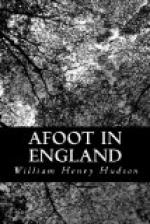In the course of a ramble on foot in a remote district I came to a small ancient town, set in a cuplike depression amidst high wood-grown hills. The woods were of oak in spring foliage, and against that vivid green I saw the many-gabled tiled roofs and tall chimneys of the old timbered houses, glowing red and warm brown in the brilliant sunshine—a scene of rare beauty, and yet it produced no shock of pleasure; never, in fact, had I looked on a lovely scene for the first time so unemotionally. It seemed to be no new scene, but an old familiar one; and that it had certain degrading associations which took away all delight.
The reason of this was that a great railway company had long been “booming” this romantic spot, and large photographs, plain and coloured, of the town and its quaint buildings had for years been staring at me in every station and every railway carriage which I had entered on that line. Photography degrades most things, especially open-air things; and in this case, not only had its poor presentments made the scene too familiar, but something of the degradation in the advertising pictures seemed to attach itself to the very scene. Yet even here, after some pleasureless days spent in vain endeavours to shake off these vulgar associations, I was to experience one of the sweetest surprises and delights of my life.
The church of this village-like town is one of its chief attractions; it is a very old and stately building, and its perpendicular tower, nearly a hundred feet high, is one of the noblest in England. It has a magnificent peal of bells, and on a Sunday afternoon they were ringing, filling and flooding that hollow in the hills, seeming to make the houses and trees and the very earth to tremble with the glorious storm of sound. Walking past the church, I followed the streamlet that runs through the town and out by a cleft between the hills to a narrow marshy valley, on the other side of which are precipitous hills, clothed from base to summit in oak woods. As I walked through the cleft the musical roar of the bells followed, and was like a mighty current flowing through and over me; but as I came out the sound from behind ceased suddenly and was now in front, coming back from the hills before me. A sound, but not the same—not a mere echo; and yet an echo it was, the most wonderful I had ever heard. For now that great tempest of musical noise, composed of a multitude of clanging notes with long vibrations, overlapping and mingling and clashing together, seemed at the same time one and many—that tempest from the tower which had mysteriously ceased to be audible came back in strokes or notes distinct and separate and multiplied many times. The sound, the echo, was distributed over the whole face of the steep hill before me, and was changed in character, and it was as if every one of those thousands of oak trees had a peal of bells in it, and that they were raining that far-up bright spiritual tree music down into the valley below. As I stood listening it seemed to me that I had never heard anything so beautiful, nor had any man—not the monk of Eynsham in that vision when he heard the Easter bells on the holy Saturday evening, and described the sound as “a ringing of a marvellous sweetness, as if all the bells in the world, or whatsoever is of sounding, had been rung together at once.”




